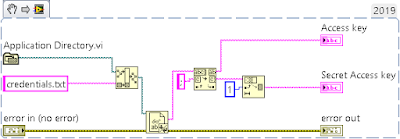LabVIEW is one of our favorite languages and AWS our favorite Cloud platform. It would be nice to use them together, wouldn't it? There is a toolkit for that, so we are going to try and use it.
It might be easy to communicate directly with the AWS services APIs, but it is great to have that job already done in the form of a toolkit. Its name is LabVIEW Cloud Toolkit for AWS by NI and you can install it from the VIPM repository. It has a set of four example services, but you should be able to add other services too with the underlying functions.
As in the previous posts, we will do some exercises using the toolkit. You need programmatic access to AWS to run the examples. If you do not have an Access Key and a Secret Access Key, ask the teacher for one (if you are one of our students) or create a free account in AWS.
As we mentioned before, it is difficult to keep your secrets in LabVIEW. If you want to share your ideas with some colleagues and you send your VIs with your keys on (you should "Make Current Value Default" for avoiding losing the IDs when sending), anybody could use those IDs for accessing any other AWS service programmatically. This is so dangerous that you should try to hide them someway. If you delete the keys, your colleagues must enter theirs in every place you use them.You could convert them to constants and share an application instead of a VI, but yur colleagues would not be able to watch the hard work you did. Is there any other way?
Let us see the block diagram of our subVI in the following picture. The picture is also a snippet, so you can drag and drop it into a blank VI and it will work.
The file credentials.txt should look like this:
AKIxxxxxxxxxxxMD;j2xxxxxxxxxxxxxxxxxxxxxxxxxxxxxxxd9
that is,
your access Key;your secret Access key
That's it! Keep Pounding! Have fun running your own examples of LabVIEW and AWS.




